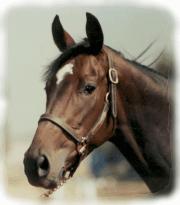A Horse, of Course with Don Blazer |
If you enjoy learning about horses, then you'll love our online courses. Each month you'll find a new column on our web site. We hope you'll enjoy it, and maybe e-mail us with questions or suggestions for other columns. A Horse, Of Course is a monthly column syndicated by Success Is Easy. If you like the column, call your local newspaper, or local horse publication and ask them to subscribe by contacting Success Is Easy. |
Wait - The Key to Horse Training Wait! In this day and age of “instant” everything, it’s hard to do, especially when you’re training a young horse, or even an older horse for that matter. It’s easy to get excited; everything is now or soon. There are show classes for weanlings, yearlings, two-year-old futurities and derbies for three-year-olds. And time flies when you are having fun. So, I’m not saying wait to get started…I don’t think you can start to soon. But wait! There are six elements to horse training: communication, the initiation of action, compliance, impulsion, suppleness and collection. There’s one super ingredient that applies to all, and makes each better. Wait! It took me years and years to figure it out. Great trainers have given me lots of help, lots of advice, lots of secrets, but never “wait.” They might not have recognized it themselves, even though most of them practiced it. Some say, “It takes as long as it takes.” But that’s not quite the same as “wait”. One of the best show-horse trainers (multiple world champions) I ever watched and tried to learn from would ask a horse for a simple exercise, then stop the horse and wait. He’d light a cigarette and just wait. He didn’t say he was waiting, he just did it. Training race horses is a little different than training show or pleasure horses…the mind set is “fast”, not “wait”. But race horse trainers will often give you this advice: if you don’t wait on a horse, he’ll make you wait. What they mean is, a horse will find a way to get hurt, sore, or mentally up-tight if you don’t give him time to learn. When training, make sure the training and conditioning is slow and easy; the horses will have good minds and sound bodies. One very successful trainer gave me this advice: when you’re trying to teach a horse something, never get him hot—mind or body. In hot weather, how do you not get them hot? You do a lot of “waiting.” He never really told me to “wait,” but that was the essence of his advice. How do you wait? Walk slowly, stop and rest, move slowly, speak in soft tones. Horses have excellent hearing, so you don’t have to make an effort to be heard. Speak softly and it starts the process of “waiting.” Now don’t hurry through the grooming process; take your time, allow your horse to enjoy the light massage, caresses and pats. Tack slowly; remember that “less is more” and “slow is fast.” You’re not really going anywhere…it’s just a training session and time for enjoyment. If you slow down your horse won’t be anxious. Allow your horse to “mosey along.” For years I wanted my horses to “walk out; come-on Paint, let’s get where we ain’t.” I couldn’t wait, even thought we had no destination. All I really accomplished was to rev-up my horse’s mind. Begin teaching…but wait. Teach in small amounts, for example, two half-pass steps to the left is a good try, now wait and provide praise. Your horse will probably want to take a step forward; it’s the nature of horses to be on the move. Wait. Make him wait some more. Now ask for a smooth, quiet, transition to something he knows..the walk, jog or lope. Only travel 20 to 30 yards, stop and wait. Make all your teaching simple. The correct responses should be both easy and comfortable for the horse…incorrect responses should result in discomfort and hard work, followed by a period of waiting. Practice waiting. It’s going to take a couple of weeks of “waiting” to see great results, but I promise, you’ll be amazed. Wait and see! Visit A Horse, Of Course on the Internet at www.donblazer.com |
